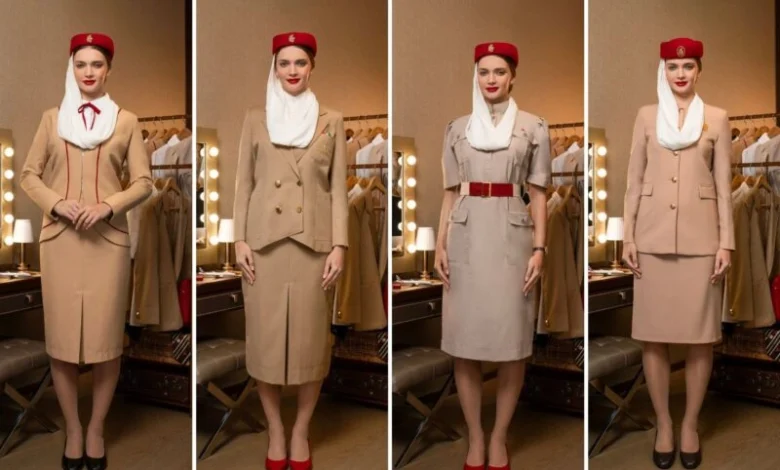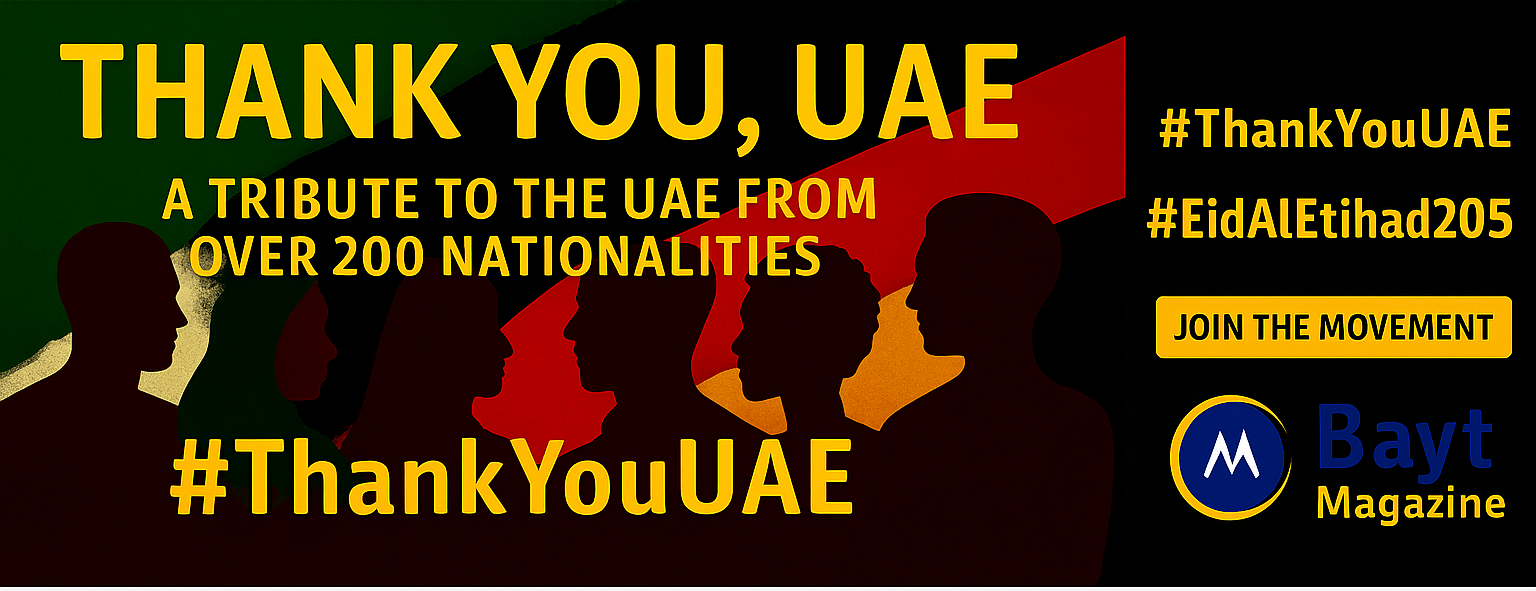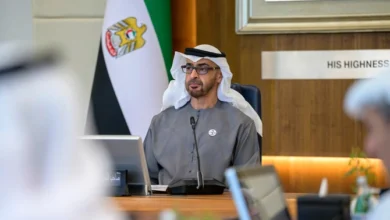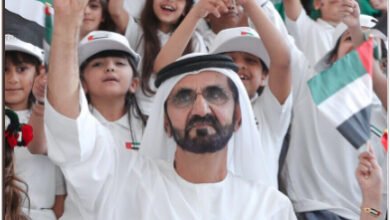
Emirates Cabin Crew Uniform Through Four Decades
Emirates’ cabin crew uniform has seen remarkable changes since its first appearance in 1985. Back then, just 80 crew members wore the brand’s signature red and gold colors. This modest beginning has grown into a symbol of luxury air travel that now strengthens 25,000 cabin crew members who fly to more than 140 destinations worldwide.
The uniform has gone through careful redesigns over four decades to blend functionality with fashion. The airline’s first routes included about 11 destinations such as London Gatwick, Frankfurt, and Mumbai. Both old and new versions of the uniform managed to keep the signature color scheme while adding modern touches. Designers focused on practical needs so crew members could move easily through aisles while serving food or helping passengers. The male and female versions of the uniform show thoughtful differences yet stay true to the brand’s identity.
This piece tells the story of Emirates’ iconic uniform and its path from simple beginnings to becoming a global symbol of premium service and aviation excellence.
1985–1996: The Birth of a Brand Identity

Emirates wrote a new chapter in aviation fashion when it revealed its first cabin crew uniform for a team of 80 members in October 1985. The bold fashion statements and exaggerated silhouettes of that era helped create one of the most recognizable looks in aviation.
The first Emirates cabin crew uniform
The original uniform captured the extravagant style of the mid-1980s. Female crew wore warm sandy-beige jackets with rounded borders and bright red piping along the edges. This design matched the “more-is-more” style of the time and included subtle shoulder pads that matched the decade’s powerful fashion statements.
A smartly tailored skirt fell just below the knee with an elegant pleat in the middle. The cream blouse and red ribbon tied into a bow around the collar completed the look. The outfit balanced professionalism with the era’s characteristic flair.
Emirates paid close attention to every detail of the cabin crew uniform from day one. The first design created several elements that became key parts of the brand’s look. These original design choices built the foundation for future changes while keeping core style principles intact.
The airline refreshed the female uniform by 1987 as it grew to serve about 11 destinations including Amman, Mumbai, Cairo, Colombo, Delhi, Frankfurt, London Gatwick, and others. The new version featured a double-breasted beige jacket with striking gold buttons, a longer skirt with an extended pleat, and a white blouse with subtle Emirates logo patterns. The company kept its trademark red hat and veil that had become brand symbols.
The airline also showed practical flexibility by creating a “Summer Safari” dress for female crew in late 1987. This alternative uniform worked better in warm weather and featured structured shoulders, stylish front pockets, and a red belt at the waist. This change reflected Emirates’ growing global reach and its focus on crew comfort in different climates.
Symbolism in color and design
The uniform’s colors and design carried deep meaning from the start. The warm sandy-beige palette connected with UAE’s desert dunes, linking the airline to its homeland. This color choice rooted the uniform in the region’s natural landscape and created an authentic Emirati identity.
Red elements served two purposes: they highlighted Emirates’ brand colors and created eye-catching contrast against neutral tones. Red quickly became a key part of the Emirates experience across all customer touchpoints.
The headwear stood out as culturally significant. The red hat displayed Emirates’ logo in detailed Arabic calligraphy, showing the airline’s cultural heritage. A cream chiffon scarf draped elegantly—respecting local customs while creating a unique look. The scarf had exactly seven pleats to represent UAE’s seven Emirates. This blend of national identity with uniform design showed remarkable attention to detail.
Gold accents added another layer of meaning during this early period. These touches appeared in buttons, insignia, and decorative elements because of their connection to Dubai. The precious metal highlighted Dubai’s history as a gold trading hub and added prestige to Emirates’ brand.
The uniform’s symbolic elements included:
- Sandy beige base: Representing the desert dunes of the UAE
- Red accents: Establishing brand recognition and visual impact
- Seven-pleated scarf: Honoring the seven Emirates of the UAE
- Arabic calligraphy: Showcasing cultural heritage and identity
- Gold elements: Connecting to Dubai’s status as a gold trading center
These design choices helped Emirates become more than an airline—it became UAE’s cultural ambassador, showing the nation’s identity worldwide.
Differences in male and female uniforms
Male and female versions of the uniform showed clear differences based on practical needs and 1980s fashion standards. The 1985 design gave male cabin crew and pilots classic gray suits with white shirts, red ties, and gold insignia. This traditional menswear created a sharp, professional look that matched international business standards.
The male uniform stayed mostly unchanged during this time, while the female version saw more updates. This let the distinctive female uniform become the brand’s main visual identifier. Passengers could easily recognize Emirates through this strategic choice.
Both male and female crew wore black leather shoes that worked well for long service hours. This element changed as the uniform developed further.
Female crew uniforms changed more noticeably than male versions. Beyond the 1987 double-breasted jacket update, First Class female crew got another option—a traditional Arabic “Thoub” dress for serving Arabic coffee and dates. This cultural addition showed Emirates’ dedication to authentic hospitality and added sophistication to premium service.
Spanish designer Paco Rabanne worked with Emirates to update their uniform look as 1997 approached. The new design kept the classic beige and red colors but added modern cuts that matched 1990s style. Rabanne created a shapely skirt for female crew with a round-neck blouse showing a jacquard logo print and a slim jacket with a mandarin collar.
Male crew got navy blue jackets with beige trousers and brown shoes—their first major change since the airline started. Working with a famous designer showed Emirates’ growing global presence and commitment to sophisticated style.
The different uniforms for men and women served both practical and marketing purposes. The eye-catching female uniform created instant brand recognition, while the male version complemented it with professional style and functionality. These gender-specific designs built a unified visual identity that mixed tradition with modern style—creating the foundation for one of aviation’s most recognized uniforms.
From 1985 to 1996, Emirates’ cabin crew uniform grew from its first design into a sophisticated brand symbol. It carefully mixed cultural meaning, practical function, and modern fashion. The thoughtful use of symbolic elements and adaptation to new needs created a visual legacy that would define Emirates’ image for decades.
1997–2007: Designer Influence and Global Expansion
Image Source: Emirates
Emirates had carried over 3 million passengers and expanded to 44 destinations worldwide by 1997, after ten successful years of operations. The airline’s growth called for a fresh uniform design that would showcase its international presence and sophisticated brand image.
Paco Rabanne’s redesign
Emirates made a groundbreaking move in 1997 by partnering with Spanish designer Paco Rabanne to create new cabin crew attire. This partnership marked the airline’s first collaboration with a world-famous fashion designer. Emirates has changed its uniforms four times, but this redesign stands out as a defining moment in the cabin crew uniform’s history.
Paco Rabanne had a clear goal: keep the signature colors while adding modern touches that fit 1990s fashion trends. His design blended tradition with contemporary style and kept the brand recognition intact with refined esthetics. Rabanne didn’t just update the existing uniform – he reimagined it completely. His design improved both looks and functionality.
Female crew members got a shapely skirt with a round-neck blouse featuring a jacquard logo print. The pattern added subtle detail up close without being too flashy. A slim jacket with a mandarin collar completed the look – a new touch that reflected Asian fashion influences in Western design at the time.
The choice to keep the beige and red colors showed Emirates’ dedication to its brand identity. This color combination had become the airline’s signature look, with beige representing UAE’s golden desert sands. The familiar colors helped passengers spot Emirates crew members easily, even with the updated style.
Modern tailoring and new color accents
Rabanne’s design brought cleaner lines and fresh color touches that matched 1990s style. The women’s uniforms kept their classic beige base but got sleeker cuts that created a streamlined look compared to the fuller 1980s designs. This update perfectly matched late 1990s fashion, which preferred simple lines over the bold shapes from earlier years.
The accessories got a notable update. Red shoes had been a key part of the female crew uniform before this change. The 1997 design switched to brown bags and shoes instead. This change created a smoother overall look by softening the contrast between uniform pieces. The new accessories matched the beige clothes perfectly while keeping up with fashion trends.
Male crew members saw big changes too. Their new uniforms featured navy blue jackets with beige pants and brown shoes. This look was quite different from the previous design and created a clear visual difference between male and female uniforms right when Emirates was growing worldwide.
Both male and female uniforms shared careful attention to detail that showed Emirates’ focus on a unified look. Despite different styles for men and women, several elements tied the uniforms together:
- A shared beige color scheme
- The same high-quality fabric and finish
- Matching brown accessories (shoes and bags)
- Uniform badges and logo placement
The new uniform kept important cultural symbols that linked the airline to its roots. The cream Emirates scarf still had seven pleats to represent UAE’s seven emirates. This detail kept the uniform’s cultural meaning strong as the airline grew internationally.
Uniforms for a growing international crew
Emirates grew amazingly fast during this decade, changing from a regional airline into a global aviation leader. The uniform redesign came during a time of major growth in both planes and routes. Emirates had hired about 1,500 cabin crew members when the 1997 design launched – a huge jump from its first team.
The airline served many more destinations with a much bigger workforce by the decade’s end. The uniform needed to work well in different climates, cultures, and service settings. Rabanne’s design proved perfect for long flights across multiple time zones and weather conditions.
The uniform’s practical aspects became crucial as Emirates went global. Crew members now came from over 140 countries and spoke 130 languages. This mix meant the uniform had to fit different body types and cultural needs while keeping Emirates’ brand image consistent.
Emirates reached another milestone when it got its first Airbus A380 in July 2008. The airline now had about 11,000 cabin crew members serving 99 destinations worldwide. This massive growth led to another uniform update to mark a new chapter in the airline’s story.
The next design, created in-house with Simon Jersey, kept the iconic beige and red colors from earlier versions. It added subtle pinstripes, pleated skirts with more red details, and new accessories that would define Emirates’ look for years ahead.
Over four decades and several redesigns, Emirates’ cabin crew uniform has kept its core elements while adapting to new fashion trends, practical needs, and the airline’s growing global presence. From Rabanne’s influential 1997 design to later versions, each uniform built on what came before, creating a lasting look that people recognize in airports everywhere.
2008–2019: The Signature Look Takes Shape

Image Source: Time Out Dubai
July 2008 became a milestone for Emirates when the airline received its first Airbus A380 aircraft in Hamburg, Germany. The company also revealed a refined cabin crew uniform that became its most recognizable look. The redesign came from Emirates’ in-house team working with uniform supplier Simon Jersey. They kept the iconic color palette that people associated with the brand and made subtle changes to raise its visual appeal.
Introduction of pinstripes and pleats
The 2008 redesign kept the 15-year-old beige and red color scheme but brought improvements that gave the emirates cabin crew uniform its signature look. Female crew members got uniforms with subtle pinstripe patterns that created visual texture without overpowering the classic silhouette. This detail added sophistication while keeping the timeless appeal.
The most notable change came with four kick pleats in the skirt. These pleats showed more of the airline’s signature red color as crew members walked, which created a dynamic effect throughout the cabin. Fresh red trims appeared throughout the suiting and deepened the connection to Emirates’ brand identity.
Male crew members saw big changes in their uniforms too. Their new look featured rich chocolate brown pinstripe with subtle red trim, replacing the previous navy blue design. A cream shirt and a distinctive striped tie with gold, brown, and red tones completed the look. The uniform projected luxury and refinement that matched Emirates’ status as a premium carrier.
Both male and female versions of the emirates airlines cabin crew uniform shared design elements through matching color palettes and complementary styling. This created a unified look across the crew, whatever their gender or role. The airline’s workforce had grown to 11,000 cabin crew serving 99 destinations worldwide, making this uniform consistency vital for brand recognition.
Accessory updates: hats, shoes, and bags
The 2008 emirates cabin crew uniform brought significant changes to accessories. The female hat got a new design with the Emirates logo placed on the side in a wing shape. This change made the brand more visible while keeping the hat’s elegant look.
Accessories got slightly darker maroon red shoes, belts, and bags that matched the uniform’s trims and the iconic hat. Every element worked together to create a harmonious look throughout the ensemble.
Female crew members’ footwear became a key part of the uniform. The 2008 design brought back red shoes in a deeper maroon shade. Emirates later gave female crew members 15 different shoe styles to choose from. This approach put comfort first while keeping a consistent look – something rare for airline uniforms.
The red hat featured a gold pin with the Emirates logo, connecting to Dubai’s history as the “City of Gold”. The cream chiffon scarf draped on the hat continued to represent local culture. The veil kept its seven pleats, symbolizing the seven Emirates of the UAE.
By 2023, Emirates brightened the red shade used in female crew shoes and matching leather handbags to better complement the skirt pleats and uniform trim. This small change showed how the airline kept improving its iconic look while preserving its character.
Uniforms designed for long-haul comfort
The emirates cabin crew uniform focused on practical features needed for long-haul flights. Comfort became crucial as Emirates flew to more places worldwide, with crew working flights across multiple time zones and weather conditions.
The uniform fabrics resisted stains and creases – key qualities for looking impeccable during long flights. Crew members could maintain their professional appearance even after hours of service.
The design worked well in different climates, which mattered for crew who flew worldwide. A crew member might work in São Paulo’s summer heat one day and Moscow’s winter cold the next, so the uniform had to work in extreme conditions.
Female crew got two pairs of red leather shoes each year – flat shoes for comfort during service and medium or high heels for boarding and deplaning. Male crew received new leather shoes every nine months.
The 2008 design balanced looks with practicality, creating a uniform that looked great and worked well in demanding airline conditions. This attention to detail showed Emirates’ dedication to excellence in every aspect.
The emirates cabin crew uniform female version, with its beige suit, red accents, and iconic hat, became famous worldwide. The emirates cabin crew uniform male version, with chocolate brown pinstripe and matching accessories, showed sophistication and professionalism. Together, they helped make Emirates a global aviation leader.
From 2008 to 2019, these uniforms represented Emirates as thousands of crew members wore them across an expanding network. The look proved so successful that it stayed mostly unchanged, with only minor updates instead of complete redesigns.
This uniform design has lasted because it combines timeless style with practical function. Many airlines change uniforms to follow fashion trends, but Emirates managed to keep its signature look for over a decade, showing confidence in its visual identity.
2020–2025: Personalization and Performance
The dawn of 2020s saw Emirates move away from complete uniform overhauls. The airline focused on careful improvements that put crew comfort first while keeping its visual identity intact. Their iconic uniform went beyond just looks. The airline added personalization choices and technical improvements to meet the needs of its worldwide crew.
New Emirates cabin crew uniform features
Emirates cabin crew uniform entered a new phase of personalization. This was a big change from the standard one-style approach most airlines used. The airline knew its crew members had different priorities, especially with staff from more than 140 countries.
The uniform’s signature elements stayed the same. Warm sand-colored suits still represented UAE’s desert dunes. The red hat with its gold Emirates logo pin remained iconic. The cream chiffon scarf kept its elegant drape with seven pleats for the seven Emirates. Under these familiar visual elements, small but useful changes made the uniform more practical.
The uniform’s design now adapts to different weather conditions. This helps crew members who fly between extreme temperatures. To name just one example, see how crews might fly from Brazil’s heat to Russia’s winter cold in a single work schedule. These practical design elements showed Emirates’ smart approach to uniform updates.
15 shoe styles and brighter red accessories
Emirates launched its most important personalization program in 2023. Female cabin crew could now pick from 15 different shoe styles. These Spanish-made leather shoes came in various heights, widths, shapes, and styles. Female crew got two pairs of red leather shoes each year – flat shoes for comfort during flights and their choice of medium or high heels for boarding.
The airline also brightened its red accessories. New female shoes came with matching leather handbags and belts in a more vivid red. This brighter shade matched perfectly with the skirt’s pleat and uniform trim. It strengthened the red accent that people worldwide now link to Emirates.
This update connected nicely with Emirates’ history. Back in 1985, Emirates cabin crew first wore red shoes. The color changed to brown for a while before returning to its signature red. Modern manufacturing and personalization options helped honor this tradition while meeting today’s crew needs.
Nano-coated fabrics and technical upgrades
Technical breakthroughs became central to Emirates cabin crew uniform. New textile technology brought nano-coated fabrics that resist stains and creases better. Crews now look professional even after long flights. Their uniforms stay crisp whatever the flight duration.
Comfort, durability, and performance guided uniform development. Emirates stayed away from quick fashion trends. They created lasting garments that hold up through countless service hours.
Male crew also benefited from these improvements, though they had fewer uniform options than female staff. They received new leather shoes every nine months. This regular replacement keeps their footwear looking good and feeling comfortable.
Emirates kept its traditional grooming standards alongside these uniform improvements. Female cabin crew wear their signature look – perfect skin, red lipstick, and natural eye makeup. The red scrunchie stays available for various elegant hairstyles. Male crew keep clean-shaven faces and neat hair. These grooming rules work with the uniform to create a complete professional look.
Uniforms for 25,000 crew across 140+ destinations
Emirates’ uniform program reached an impressive scale by 2025. About 25,000 cabin crew members now wear these uniforms while flying to more than 140 destinations. This shows amazing growth from just 80 crew members in 1985.
January 2025 brought another expansion. Emirates created special uniforms for its Premium & VIP Passenger Services team. This select group helps high-profile customers and First Class connecting passengers at Dubai International Airport. Their uniforms mirror the cabin crew look but include exclusive details for their special role.
Emirates’ uniform team designed three variations in-house: women’s A-line skirt suits, women’s pant suits, and men’s 3-piece suits. These special outfits share the warm sand colors and red accents with cabin crew uniforms. They stand out with unique touches like subtle red collars, matching cuffs for women, and red pleats in A-line skirts that help staff move easily through the big airport.
The growing uniform program shows its vital role in Emirates’ identity. Over forty years, the Emirates airlines cabin crew uniform managed to keep its core look while adding smart improvements for changing needs. From personal shoe choices to advanced fabrics, the uniform balances tradition with progress. It projects timeless elegance that people recognize worldwide.
The Emirates cabin crew uniform has grown beyond simple corporate attire over four remarkable decades. This iconic symbol now represents luxury air travel worldwide. Fashion trends have changed dramatically since 1985, but the uniform has kept its distinctive identity while adapting to new needs.
The story started with just 80 crew members who wore the first sandy-beige uniforms with bright red accents. Today, about 25,000 cabin crew members wear these iconic outfits across more than 140 destinations globally. This development shows Emirates’ growth from a regional carrier to a world-leading airline.
Key elements have remained constant through each version. The warm sand colors still reflect UAE’s desert landscape, and the signature red accents are recognized worldwide. The cream chiffon scarf’s seven pleats continue to honor the seven Emirates that make up the UAE. This design preserves cultural significance while looking appealing.
Each redesign strikes a perfect balance between style and function. Emirates worked with designers like Paco Rabanne to bring fresh esthetics while keeping brand consistency. Recent upgrades focused on practical features – from stain-resistant nano-coated fabrics to custom footwear that keeps crew comfortable during long flights.
Emirates differs from other airlines by focusing on timeless design instead of short-lived trends. The iconic look from 2008 remains mostly unchanged, showing that great design can last when created with purpose and precision.
Female crew can now select from 15 shoe styles and receive two pairs yearly. Their handbags come in a brighter red shade that matches their uniforms perfectly. Male crew get regular shoe replacements and improved technical fabrics for comfort and professional appearance.
The Emirates cabin crew uniform shows how good design can respect tradition, accept new ideas, and maintain brand identity. After 40 years of careful updates, these iconic uniforms still represent premium service, cultural heritage, and exceptional attention to detail that define Emirates.




